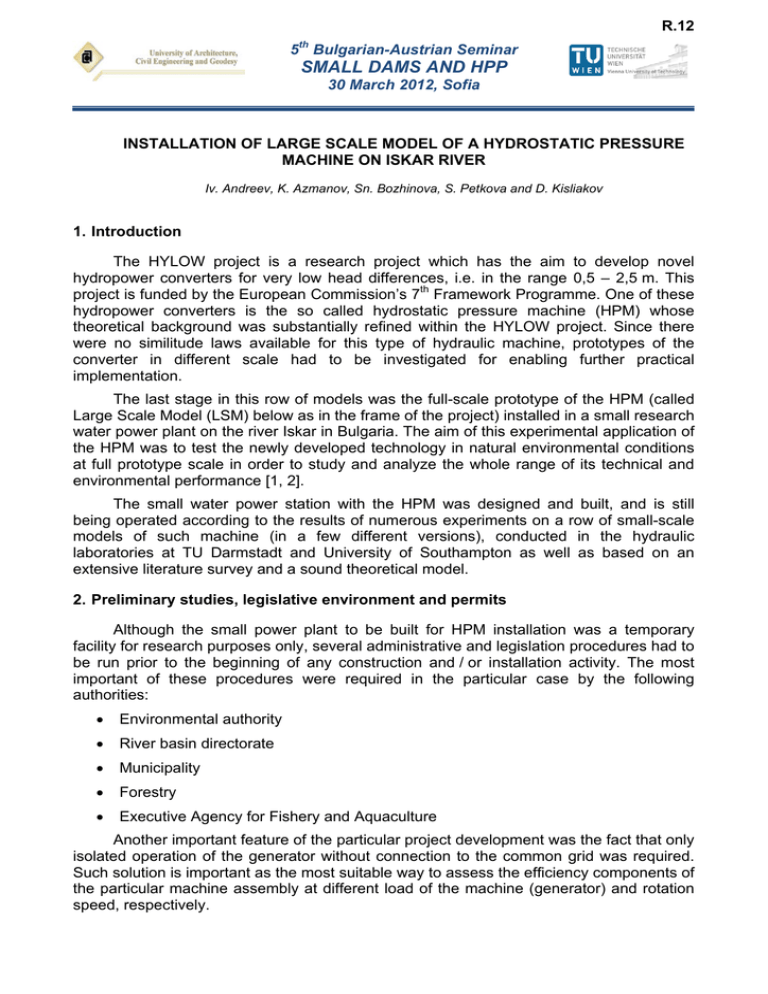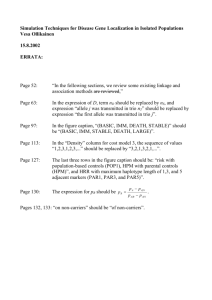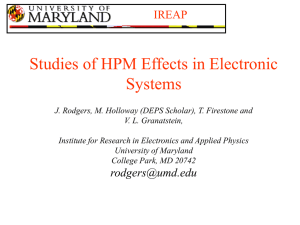SMALL DAMS AND HPP
advertisement

R.12 5th Bulgarian-Austrian Seminar SMALL DAMS AND HPP 30 March 2012, Sofia INSTALLATION OF LARGE SCALE MODEL OF A HYDROSTATIC PRESSURE MACHINE ON ISKAR RIVER Iv. Andreev, K. Azmanov, Sn. Bozhinova, S. Petkova and D. Kisliakov 1. Introduction The HYLOW project is a research project which has the aim to develop novel hydropower converters for very low head differences, i.e. in the range 0,5 – 2,5 m. This project is funded by the European Commission’s 7th Framework Programme. One of these hydropower converters is the so called hydrostatic pressure machine (HPM) whose theoretical background was substantially refined within the HYLOW project. Since there were no similitude laws available for this type of hydraulic machine, prototypes of the converter in different scale had to be investigated for enabling further practical implementation. The last stage in this row of models was the full-scale prototype of the HPM (called Large Scale Model (LSM) below as in the frame of the project) installed in a small research water power plant on the river Iskar in Bulgaria. The aim of this experimental application of the HPM was to test the newly developed technology in natural environmental conditions at full prototype scale in order to study and analyze the whole range of its technical and environmental performance [1, 2]. The small water power station with the HPM was designed and built, and is still being operated according to the results of numerous experiments on a row of small-scale models of such machine (in a few different versions), conducted in the hydraulic laboratories at TU Darmstadt and University of Southampton as well as based on an extensive literature survey and a sound theoretical model. 2. Preliminary studies, legislative environment and permits Although the small power plant to be built for HPM installation was a temporary facility for research purposes only, several administrative and legislation procedures had to be run prior to the beginning of any construction and / or installation activity. The most important of these procedures were required in the particular case by the following authorities: • Environmental authority • River basin directorate • Municipality • Forestry • Executive Agency for Fishery and Aquaculture Another important feature of the particular project development was the fact that only isolated operation of the generator without connection to the common grid was required. Such solution is important as the most suitable way to assess the efficiency components of the particular machine assembly at different load of the machine (generator) and rotation speed, respectively. Furthermore, some preliminary investigations also had to be performed prior to the development of design solutions in the particular project fields, such as geological and hydrological studies as well as surveying of the site. The scope and contents of these preliminary studies were again governed by the temporary character of the installation for research purposes only. 3. Installation of the Large Scale Model of the HPM 3.1. Civil Engineering design and construction works The small power station with the LSM of the HPM was developed onto an existing weir on river Iskar, Figure 1. This installation site was chosen after a long and comprehensive location search, and it offered both the desired head and flow rate. The existing weir was redesigned and reconstructed for the HPM installation, Figure 2 [2]. Figure 1. Existing weir on Iskar river The reconstructions of the existing weir aimed to provide the optimal conditions for testing, measurements and monitoring of the HPM performance. It consists of an upgrade of the weir structure, fish pass, water-conveying channel and a small power house for the generator and its main electrical equipment. Some of the mentioned structural facilities are shown on Figure 2 and Figure 3. 2 Figure 2. Layout of the HPM installation site The new solution of the weir had to provide the head and water discharge conditions of the HPM. For this purpose, the crest elevation of the existing weir was increased at the lowest point with approx. 1,50 m. Thus, the design head at the HPM inlet reached approx. 1,70 m. Figure 3 presents the existing weir with the new structure. Figure 3. River cross-section and some design parameters of the new weir The newly upgraded weir for the aims of the research project was built with shotcrete-faced gabions for ensuring impermeability of the upstream weir side, Figure 4. 3 Figure 4. Upstream view of the new weir during construction Figure 5. The fish pass in operation Furthermore, a fish pass was built at the weir for ensuring the continuity of the river flow through the hydraulic structures. The fish pass has a special solution developed after a series of experiments at the TU Darmstadt which had the aim to meet the requirements to the flow conditions for the particular spectrum of fish species in this reach of the river. It consists of a number of basins of different length and was entirely built of gabions, too, Figure 5. The inlet facility was equipped with an inlet sill, trash-rack and a table gate. Further, a short upstream conveying channel directs the water flow toward the HPM. After the power processing by the HPM, the water is conveyed back to the downstream river reach by an outlet connecting channel. These channels were built with gabions and shotcrete as well. For the installation of the HPM itself, a special cast-in-place concrete shaft was constructed. A side spillway was provided as well for leading away the redundant water discharge. The HPM power station site after completion of the construction works is shown on Figure 6. All these works were carried out by the Bulgarian partner within the HYLOW Project “ISTA Andreeva OOD”. Figure 6. Downstream view of the HPM site after completion of the construction works 4 3.2. Mechanical Engineering works The HPM was designed and manufactured in the turbine factory “EnergoremontPlovdiv Co” in accordance with the elaborated design drawings. The factory assemblage of the machine with all its components is shown on Figure 7. Figure 7: The factory assemblage of the HPM (ENERGOREMONT Plovdiv Co.) A special device for measurement of the mechanical torque at the machine shaft (digital torque sensor) was placed between the gear-box and the generator, Figure 7. These measurements are of crucial importance for investigation of the machine efficiency under different load conditions. The HPM shaft is connected with the generator via gear box for multiplying the speed of rotation. This two-stage cylindrical gear box has a transmission ratio of 8, Figure 7. The HPM was installed with its shaft bearings onto a preliminary encased in concrete steel support structure which supplies both the shape of the bottom under the wheel and the side walls. The second stage concrete was constructed only after wheel installation on the assembly position for reaching the design parameters, Figure 7 and Figure 8. Figure 8: Installation of the HPM 3.3. Electrical Engineering works The main electrical components are: 5 • Permanent magnet type generator with rated output power of 20 kW and rated rotation speed of 100 RPM. As already mentioned above, the generator operates not connected from the common grid. The generator loading is carried out by a resistor bank, Fig. 9. Figure 9: Gear box, torque sensor and generator, installed in the generator shaft • Power electronics converter that allows the controllable load variation of the generator. It permits the load current to vary between 0 and 48 A (DC). Thus, real time changes of the load on the generator and on the water wheel, respectively, are possible. This in turn enables investigation of the wheel operating modes and conditions in a maximum broad range, Figure 10. • Battery and charger – to ensure at least 2 hours possible proper operation of the experimental system without external power supply source, Figure 10. Figure 10: Power controller and batteries, installed inside the power house • Load resistors – 8 groups of built-in resistors, each group of 3 kW, i.e. totally 24 kW, Figure 11. 6 Figure 11: Power house and load resistors bank 3.4. Control and measuring system The measuring and control system was developed for the needs of the particular installation within the HYLOW project. The aim of the system is to measure and follow the main parameters that give an account for the HPM efficiency. The block scheme of the system is presented on Figure 12. Figure 12: Control and measuring system There are 6 input signals that have to be measured. These signals correspond to the values of water depth up- and downstream of the HPM, voltage of the generator, current of the generator, load current of the generator, torque and speed of rotation of the generator, respectively the rotational speed of the wheel. The water levels up- and downstream of the machine are measured by means of hydrostatic pressure transmitters. The positions of the transmitters were carefully selected to supply optimal data about the water levels in the front of and after the HPM, Figure 13. The monitoring of the water levels is of particular importance for determination of the HPM performance. 7 Figure 13: Position of the hydrostatic pressure transmitters The other important indicators about the performance of the machine are the electrical parameters and the parameters of the mechanical components of the HPM, as follows: • The voltage and the current, measured by voltmeter and amperemeter, respectively. These devices were installed in the power controller, placed in the power house. • The torque and speed of rotation are measured by means of the digital torque transducer, as mentioned above. The torque sensor was installed on the shaft between the gear box and the generator, so it measures the rotational speed of the generator, Figure 7 and Figure 9. Another important parameter that directly influences the HPM performance is the water flow through the wheel of the HPM. A sharp-crested weir for measurement of this discharge was installed in the downstream channel, and so the water discharge can be calculated [3], Figure 14. Figure 14: Sharp-crested weir for discharge measurement In addition to the above described acitvities, a small power house with dimensions of 3,50 m by 4,00 m was constructed, Figure 11. It consists of a concrete generator shaft and 8 wooden structure above ground and is situated on the left river bank, just next to the existing concrete wall. Most of the main electrical equipment units are installed in this power house except the load resistors which are outside it, Figure 11. 4. First results and environmental compatibility [4] Some of the most important results from the measurements carried out so far can be summarized as follows: • The maximum achieved power output so far was about 6 kW (electrical); • The best mechanical efficiency (on the machine shaft) has reached over 65%. A special research program was carried out by an expert team at the University of Southampton for the Environmental Impact Analysis of the developed concept of the small power plant with HPM with an emphasis on the impact on the fish passage through the facilities. Some of the main results obtained so far in this connection are as follows: • For fish passage through the weir in both directions, a fish pass was built with parameters developed at the TU Darmstadt (Germany). It proved to work well although the observations were performed mainly outside the time of active migration. • Statistically representative mortality and injury tests were carried out with typical species both local and common for Europe (e.g. trouts). • The mortality through the HPM is in fact 0, injuries were observed by 2-3% of the larger fishes which can easily not be allowed into the HPM with simple measures (e.g. appropriate trash-rack bar distance). • In general, it is important that the fish pass was developed with respect to the particular ichthyo-fauna spectrum and local hydro-morphological conditions. 5. Conclusions and further tasks The following conclusions can be drawn from the performed measurements during the research operation of the HPM so far [4]: • A complete Energy Convertor solution for very low head differences has been developed and successfully implemented as a full-scale prototype application; • The developed engineering know-how covers the whole process from site location via energy production up to dealing with extraordinary situations; • In this head range (1 – 2 m), the developed and implemented in full scale Hydraulic Pressure Machine successfully proves so far to be a quite competitive alternative to the usual energy producing technologies; • The implemented concept is environmental friendly and in fact recovers the continuity of a water body disturbed by an existing weir. The following fields of work and particular activities can be formulated as tasks for future research: • Further improvement of the machine design in the sense of better efficiency; • Development / implementation of the modular concept for more convenient practical application; • Completing the experimental research program; 9 • Simplifying the control and monitoring system for commercial applications (the current concept serves mainly research purposes and hence contains some additional components); • Adjustment of the Electrical Engineering Part to common grid operation, too. References 1. Senior. J., Müller. G., Low head hydropower converters, part 2: The hydrostatic pressure machine, Journal of Hydraulic Research, 2010 (submitted) 2. Azmanov K., Bozhinova S., Andreev I., Design and construction of a novel low head hydropower convertor at River Iskar – Bulgaria, Dresdener Wasserbauliche Mitteilungen, 2011 3. Казаков Б., Мараджиева М., Даскалов К., Лисев Н., Калчев И.,Захариева В. Таджер Ж., Цанков Б., Справочник за хидравлични изчисления на водопроводящи съоръжения и системи, 2009 4. Andreev, Iv., K. Azmanov, Sn. Bozhinova, S. Petkova and D. Kisliakov, “Full-scale prototype installation of a Hydrostatic Pressure Machine on river Iskar in Bulgaria” (Presentation), HYLOW Workshop, Univ. of Southampton, 7th November 2011 10





